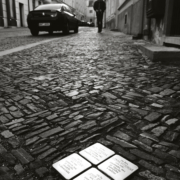Stolperstein
Since 1996 over 107,000 Stolperstein plaques have been placed in almost 1,900 German and other European municipalities, each bearing the name of one victim of Nazi persecution and so forming the world’s largest decentralised monument. Around 600 are now created each month and in many cases personally installed by the German artist who originated them, Gunter Demnig, in the surface of the street at the person’s last known home. Names are provided to this grassroots project by local researchers, who also cover the cost of each stone they propose. The stones are actually brass plaques on concrete cobbles, and are installed only with consent of the relevant local authorities.
A literal English translation of Stolperstein would likely be “stumbling stone”, but rather than suggest a stumbling block or an obstacle to trip over, a better translation would suggest stumbling upon knowledge or stumbling across, or into, a memory. English could improvise the term memory-cobble or memory stone or stumblestone but the unique nature of these stones suggests that the definitive term for them will remain Stolperstein even in translated texts.
Between 1933 and 1945 the Nazi dictatorship in Germany systematically murdered many millions of defenceless victims throughout Europe, selecting them for their politics, religion, ethnicity, or disability, then usually transporting them first to concentration camps for mistreatment and even economic exploitation before killing them.




